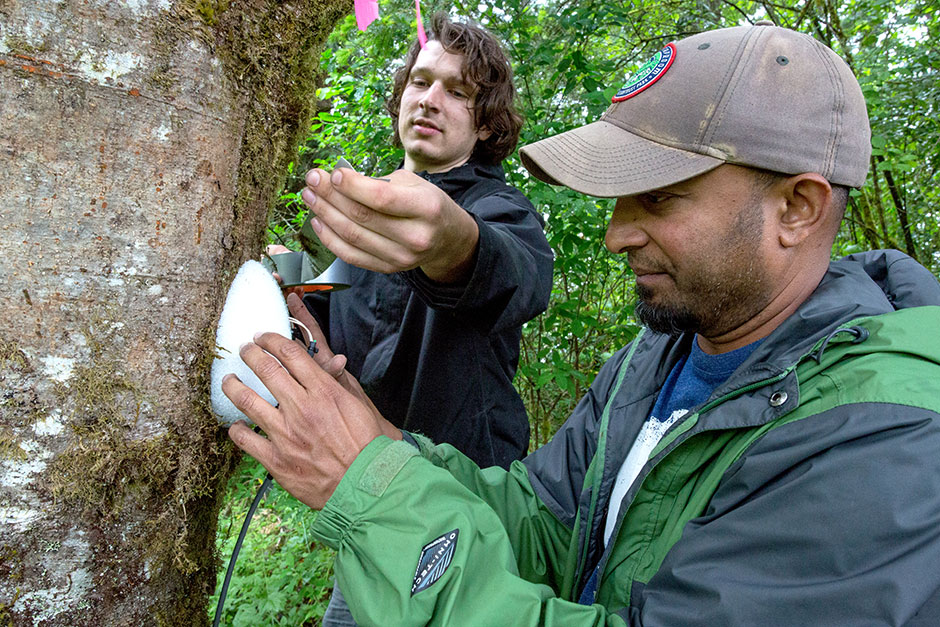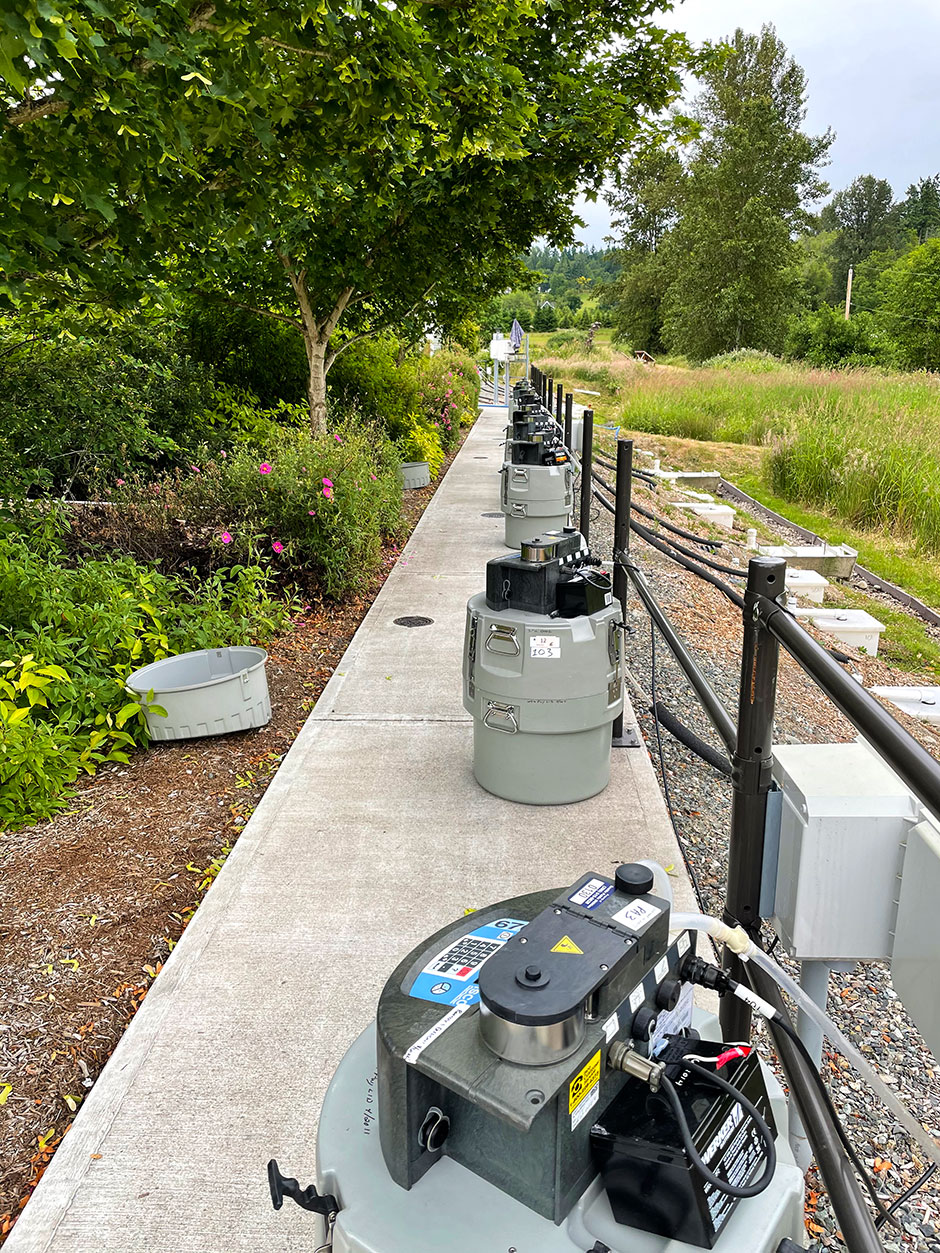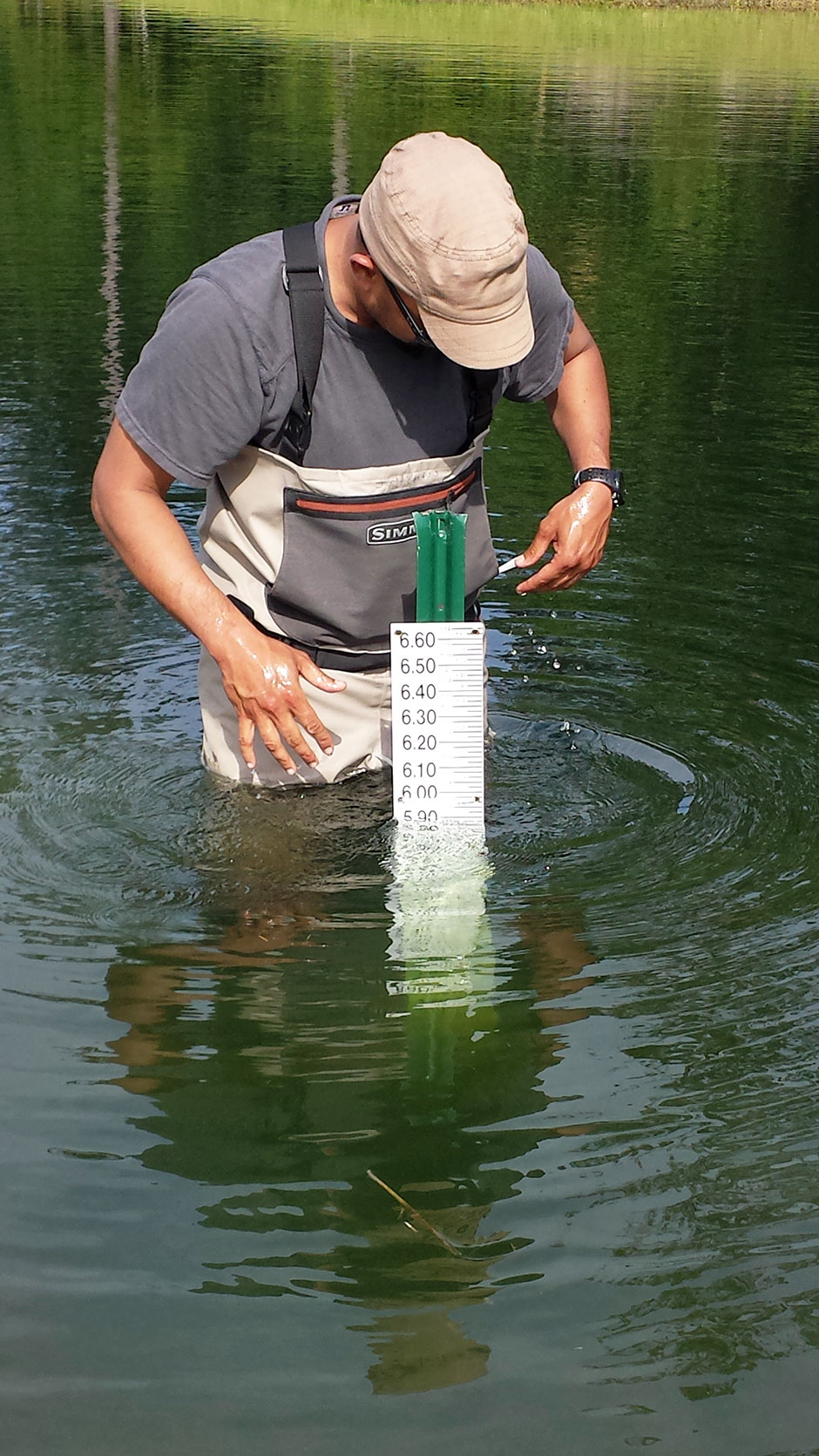Green Guidance: Forests Point the Way to Better Stormwater Management
 Ani and a graduate student installing sap flux sensors in a Big Leaf Maple tree to determine the rate at which sap moves up the tree trunk – an indication of how much water a tree can transpire (Credit: Jason Berg)
Ani and a graduate student installing sap flux sensors in a Big Leaf Maple tree to determine the rate at which sap moves up the tree trunk – an indication of how much water a tree can transpire (Credit: Jason Berg)Working as a water resource faculty and ecosystems engineer with a university on the east coast, Ani Jayakaran learned to look at forests and watersheds as guides for better water management, especially stormwater runoff. “I learned how forests and undeveloped watersheds manage water, and my goal has always been to take the approaches of nature and bring them to urban watersheds and ecosystems,” Jayakaran says. “I wanted to look at our current urban ecosystems to see how we could make them more useful and relevant to people, but also use nature as a guide to making them more effective and sustainable. They are currently pretty degraded environments, so we must incorporate some natural strategies to manage them better.” To be clear, many other researchers have also studied nature-based solutions to manage stormwater in recent years. However, it should be emphasized that the management of ecosystems using natural processes has been underway for millennia, overseen by indigenous communities worldwide.
Learning from Nature
In his current positions as a professor and as a green stormwater infrastructure specialist at Washington State University, Jayakaran has explored incorporating natural strategies for stormwater runoff into city environments. He has been leading the way in improving green stormwater infrastructure in urban landscapes. Green stormwater infrastructure research includes looking to distribute the management of stormwater across a landscape, similar to how the forest does it: treating and managing water close to where it originates instead of moving it far away before storage or treatment.
Green stormwater infrastructure involves recreating natural hydrologic processes, such as those found in forest landscapes, to control water flow and manage stormwater pollution. These features include using trees, plants, and soils to slow down the speed and volume of stormwater. With the green stormwater infrastructure approach, the work of managing water is distributed to natural soil and water features of small areas to catch and filter water. Green stormwater infrastructure strategies contrast how stormwater is managed in most urban environments.
“Currently, in most urban environments, we use ditches to collect water. The ditches send the water to a central area for storage and some treatment. The water is transported with pipes and gutters, and these systems simply can’t manage all the water that comes to them,” Jayakaran explains. “Green stormwater infrastructure would enable rainwater to be managed right at its source, where it hits the ground. Instead of transporting it to be treated like we do now, we could create small green spaces. This would be more efficient and would do a better job at treating toxins and preventing them from being transported to other areas where they can do considerable damage.”

Automated ISCO samplers being used to collect stormwater samples for water quality analysis to determine how well bioretention systems treat stormwater. (Credit: Ani Jayakaran)
Communicating Data
Jayakaran collects all sorts of data to support his green stormwater infrastructure studies. These data include water quality data, such as pH, temperature, conductivity, dissolved oxygen, dissolved organic carbon, and sediment. Water quantity data includes flow rate and volumes. He also measures soil moisture data taken within rain gardens. Vegetation data includes size, how quickly plants grow in the rain garden, and the rate of sap movement from roots to leaves in trees using sap flux sensors.
“I do research and also develop educational materials,” Jayakaran emphasizes. “I recognize that it’s not enough to carry out rigorous science; we must also take that science to the community meaningfully and understand what is important to communities before we expect them to care about our work.”
To do their work well, Jayakaran and his team must meet the challenges of what stormwater infrastructure might mean to the community when it is rolled out. Their goal is to address decisions and solutions in ways that are equitable to all community members. For example, he acknowledges that low-income communities have challenges that other communities may not face. “They frequently must deal with higher metals in their environment, more water pollution, and greater temperature extremes,” says Jayakaran. “One way of dealing with these issues is to make their environment greener. If we put in more green areas in urban cores, these areas can mitigate urban heat islands and the effects of anthropogenic climate change. In addition, greening an area has both physical and psychological benefits: having green plants around also lowers mental stress.”
Jayakaran also emphasizes that getting community buy-in before beginning a project is essential. “We first must ask the community if they want green spaces and trees. This is because greening an area can have unintended consequences. For example, green gentrification can happen when a city goes in and puts in a park,” Jayakaran explains. “If you put a new park in, suddenly, people might like the new green space and want to move there, raising home and rent prices, and this can force lower-income people to move out, which was an outcome no one intended. So, for something like this to work effectively, the community must be involved, and measures must be placed in the project to counteract things like green gentrification.”
Conclusion
A major goal Jayakaran has for green stormwater infrastructure is generating information for different groups and needs: from students to elected officials. He is currently focusing on stormwater running off roads and the 6-PPD quinone toxin that often comes with it. 6-PPD quinone has been known to be highly toxic to juvenile salmon. The toxin is produced when oxygen or ozone in the environment reacts with the 6-p-phenylenediamine (6-PPD) antioxidant put in tires to prevent them from breaking down. However, on the positive side, researchers at WSU have found that when 6-PPD-q from stormwater is put through a rain garden, it is removed by the plants and soils in the rain garden.
In addition to 6-PPD quinone studies, studies are also being conducted on mitigating the effects of climate change on stormwater management and green infrastructure management. The future is expected to be hotter and with more severe storms, and it’s important to consider now how that might be managed in the future.
In the future, Jayakaran hopes to see more diversity and equity in the world of stormwater management and green stormwater infrastructure, a group more reflective of the communities they serve. He also hopes to see cheaper, more reliable, and more widely deployable sensors for data collection. Jayakaran says some green infrastructure improvements are already within everyone’s reach. “Add a layer of mulch, you will get much more water retention, and you can lower your weeding efforts a lot. Put in a rain garden plus mulch, and you are already doing something helpful.”

Ani installing a staff gage to measure water levels in a stormwater retention pond (Credit: Katie Jayakaran)




Jim Amon
September 2, 2022 at 4:55 pm
Another challenge is maintaining the rain gardens and mulch. Who does it? what is the cost? Choosing flora that is perennial and stays the proper size helps. Community involvement can help but needs leadership so incentives need to be present. Stormwater impacts are often outside of the neighborhood so the large community needs to buy in to the project. The work you are doing is great and very useful. I wish you luck on implementation.
Sara
September 8, 2022 at 5:07 am
The work you guys are doing is commendable. Thanks for sharing the post and inspiring!